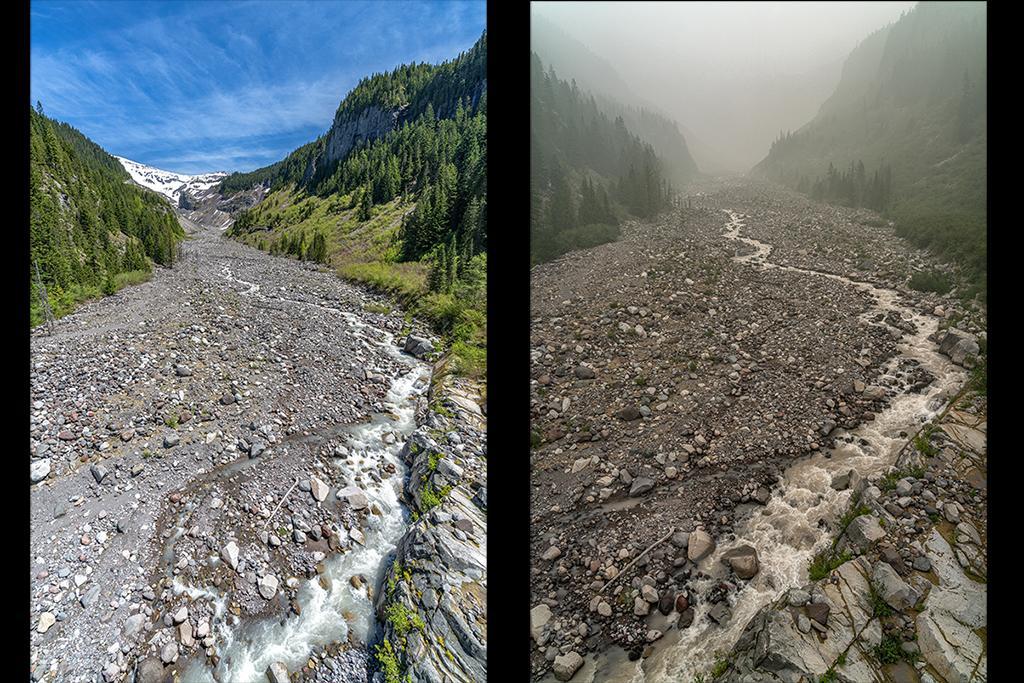
Smoke from wildfires obscured views in Mount Rainier National Park in 2020/Rebecca Latson file
From Acadia to Zion, there are health concerns across the National Park System tied to poor air quality conditions that the National Park Service has long tracked but which recently were briefly paused.
Pollution from power plants, industrial sites, traffic, and even agricultural operations have long created health and visibility problems for park visitors. High ozone levels can choke the lungs, particularly in senior citizens and those with pre-existing conditions, such as asthma.
High nitrogen and sulfur deposition can harm natural resources, smokestack emissions can create hazy visibility, and wildfire smoke can both harm your health and obscure skies, as was the case in September 2020 when the National Park Service closed both Yosemite and Kings Canyon national parks in California in September 2020 due to smoke from the SQF Complex of fires. But there also are monitors that track levels of dangerous sulfur dioxide gases vented from Kīlauea volcano at Hawai'i Volcanoes National Park.
In 1977, amendments to the Clean Air Act gave the Park Service "legal responsibility to protect air quality and sensitive resources in parks."
"The NPS operates the most complete, most respected rural air quality monitoring network in the world," said Bob Krumenaker, who was chief of natural resources for two different Park Service regions during his four-decade career with the agency. "The Clean Air Act set a national goal to 'preserve, protect, and enhance the air quality in national parks, national wilderness areas, national monuments, national seashores, and other areas of special national or regional natural, recreational, scenic, or historical value.'
"Not only would the loss of real time air quality data risk violating the law, but it would likely result in the degradation of visibility, and tolerance for a return to high levels of sulfur, nitrogen, and particulates which damage sensitive park ecosystems," he added Tuesday. "If this monitoring system is dismantled, parks will suffer over the long term increased loss of species and biodiversity."
Last week Interior officials told two outside contractors that handle the monitoring work to halt it. However, that order was later reversed and the contractors were told to resume their work, the Park Service said Tuesday. The Washington Post was first to report the halt.
At the Association of National Park Rangers, Executive Director Bill Wade recalled the value of air quality monitoring when he was superintendent of Shenandoah National Park.
“I spent almost three years as superintendent at Shenandoah National Park developing the air quality monitoring system there. Over that time and since, we significantly improved the visibility and the healthy air for park visitors and ecosystems," Wade said Tuesday. "Stopping the air quality monitoring program would be a step to reverse all that. This would be extremely unfortunate, and contrary to existing federal laws."
Tom Banks, an ANPR member, said the organization "strongly supports maintaining air quality monitoring and protection – and related scientific programs and protective measures in our national parks – which help guarantee that the National Park Service fulfills its historic mission of conserving the parks, the scenery, the wild life and other natural and cultural resources, for the benefit of present and future generations. We need to stand against the loss of protective measures for our parks, and strongly urge the administration to continue the National Park Service’s air quality monitoring efforts."
The Post's report on Monday drew a harsh response from the Sierra Club.
"This is an appalling move by the administration, especially considering the haze, wildfire smoke, and worsening air quality conditions that have plagued many areas of the country the past few years," said Jackie Ostfeld, the Sierra Club Outdoors for All campaign director. "Instead of working to protect the health of our communities, increase access to the parks as summer vacations approach, or address any of the reasons behind air quality issues in our treasured and iconic national parks – wildfires, industry, pollution – the administration is cutting programs designed to keep our outdoors safe and accessible.”
A 2024 report by the National Parks Conservation Association noted that 97 percent of parks have 'significant' or 'unsatisfactory' levels of air pollution. Parks with the greatest ozone problems, NPCA's study found, were in California, along with Rocky Mountain National Park in Colorado, White Sands in New Mexico, Guadalupe Mountains in Texas, and Indiana Dunes in Indiana.
Nitrogen deposition, largely generated from agricultural operations and motor vehicles, was a significant problem in 248 units of the park system, NPCA found. At Rocky Mountain, these emissions, arriving in the park in what is known as "wet deposition," are carried by rainfall and snowstorms.
“Long-term research in Rocky Mountain National Park has found that, over time, increasing nitrogen deposition has caused changes in soils, alpine tundra plant communities, spruce forests, and alpine lakes,” the Park Service has said in the past.

 Support Essential Coverage of Essential Places
Support Essential Coverage of Essential Places






